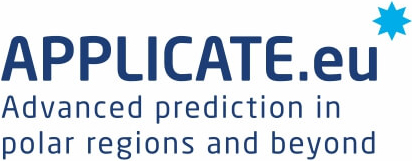Key questions
To determine the impact of Arctic climate change on the Northern Hemisphere mid-latitudes, a set of coordinated multi-model experiments will be carried out within the project. The sensitivity of the response to the background flow and the regional distribution of ice anomalies will be explored, and atmospheric and oceanic pathways for polar-mid-latitude linkages will be identified. The linkages will be studied from a prediction perspective.
The project aims to develop a set of metrics and diagnostics that target key processes in the Arctic atmosphere, sea ice and ocean as well as user-relevant information. We apply these tools to assess the realism of both existing models (baseline) and improved models developed during the project, to make advanced metrics and diagnostics available in the Earth System Model eValuation Tool (ESMValTool, Eyring et al. 2015). In this way we can explore the concept of emergent constraints in the Arctic for narrowing the uncertainty of regional climate change projections.
- Enhancing formulations of the atmospheric boundary layer, clouds, sea ice (rheology and thermodynamics), snow (multi-layer schemes) and Arctic Ocean (meso-scale features)
- Improving the representation of fluxes (mass, energy, momentum) at the atmosphere-ocean-sea ice interfaces
- Exploring the benefit of horizontal resolution
- Making extensive use of a hierarchy of models in conjunction with observational data
The project will contribute to the future Arctic observing system by:
- Analysing the impact of existing data from operational model output and reanalyses
- Carrying out and analysing atmospheric and coupled observing system (‘data denial’) experiments
- Proposing strategies for enhanced observational capabilities
- Providing a tight link to EU H2020 BG-9-2016
- An integrated Arctic observation system and the Year of Polar Prediction (YOPP)
The existing prediction systems are first analysed. Afterwards, when models are improved as project task, the impact of enhanced models and initialization strategies are evaluated against the initial analysis. As a result of this comparison, we are then able to provide recommendations for the advancement of forecasting systems fort the Arctic and Northern Hemisphere.
- Establishing close collaboration with other relevant national, European and international projects (e.g. Research and Innovation Actions under EU H2020, Belmont)
- Engaging with relevant external partners institutions (e.g. Environment and Climate Change Canada)
- Ensuring alignment with and contribution to relevant international activities such as YOPP and the US CLIVAR Working Group on Arctic Change and Possible Influence on Mid-latitude Climate and Weather.
APPLICATE aims to establish an effective dialogue with key stakeholders. Stakeholder engagement aims to disseminate the project results widely, but also to exploit means such as project and data portals through international frameworks (WMO, ICSU, SAON etc.), to implement enhancements in operational prediction systems and transition into Copernicus services (C3S), to involve partners from both weather and climate communities, and to develop a training programme in collaboration with the Association of Early Polar Career Scientists (APECS).
